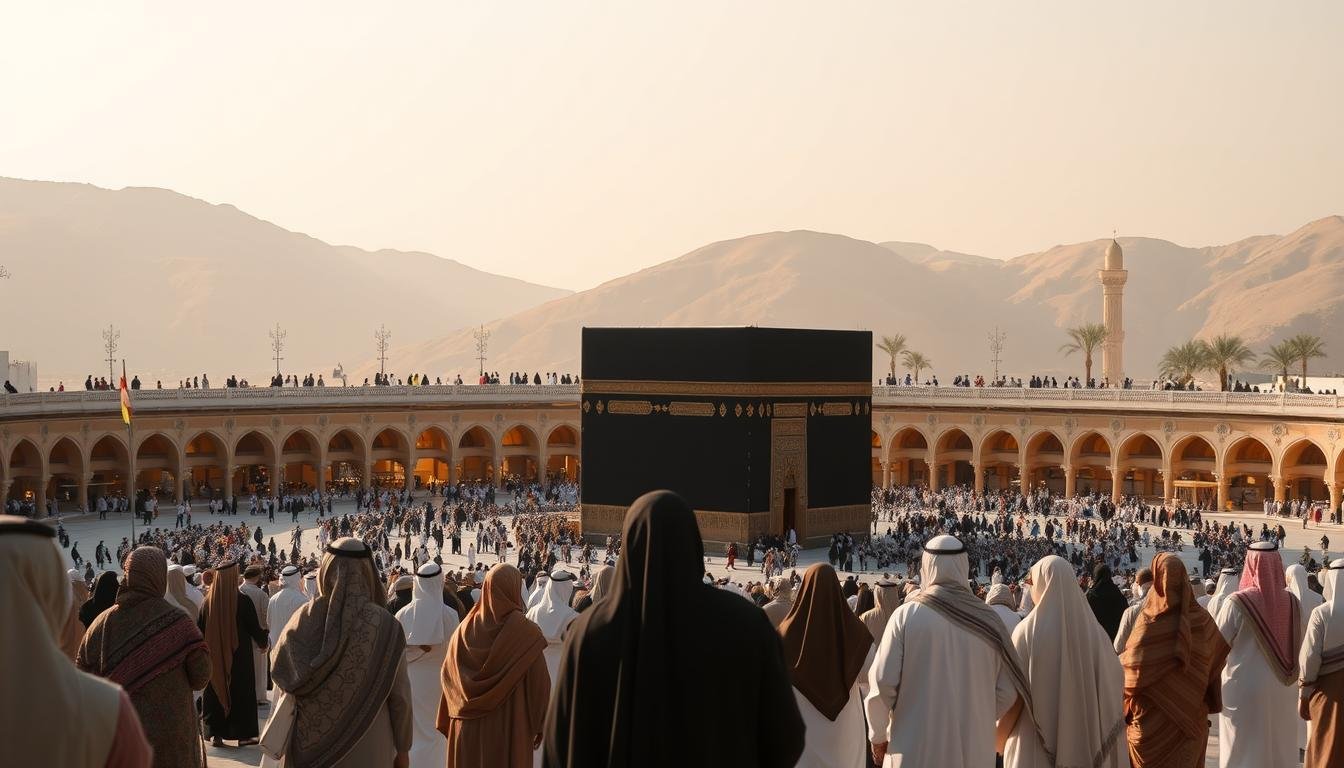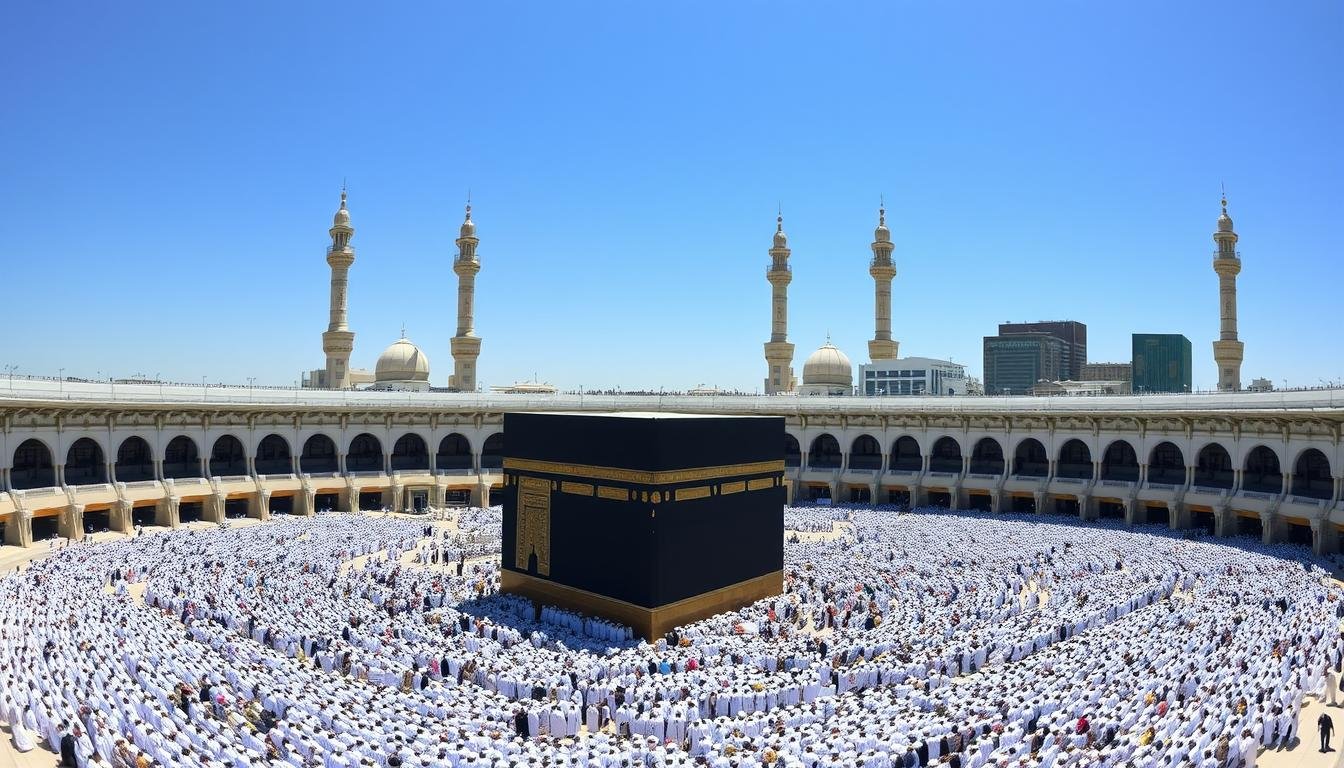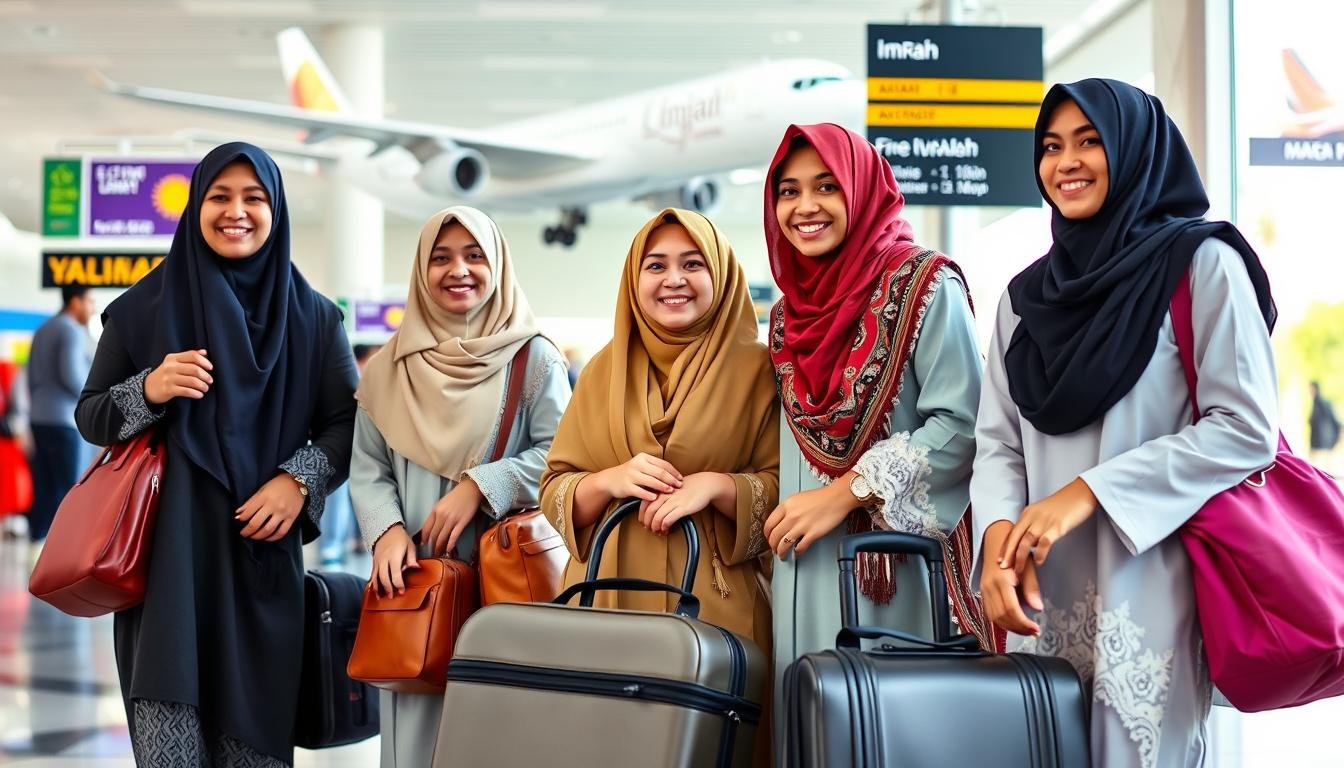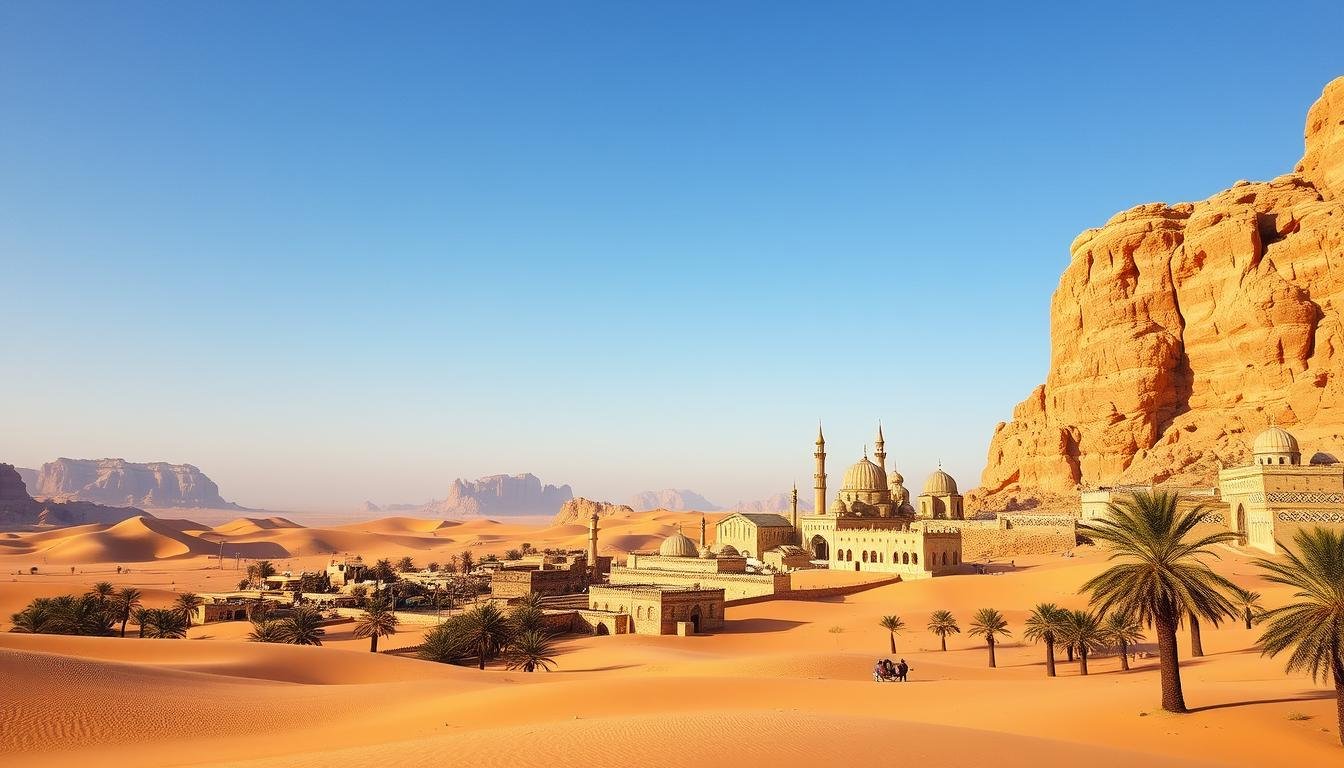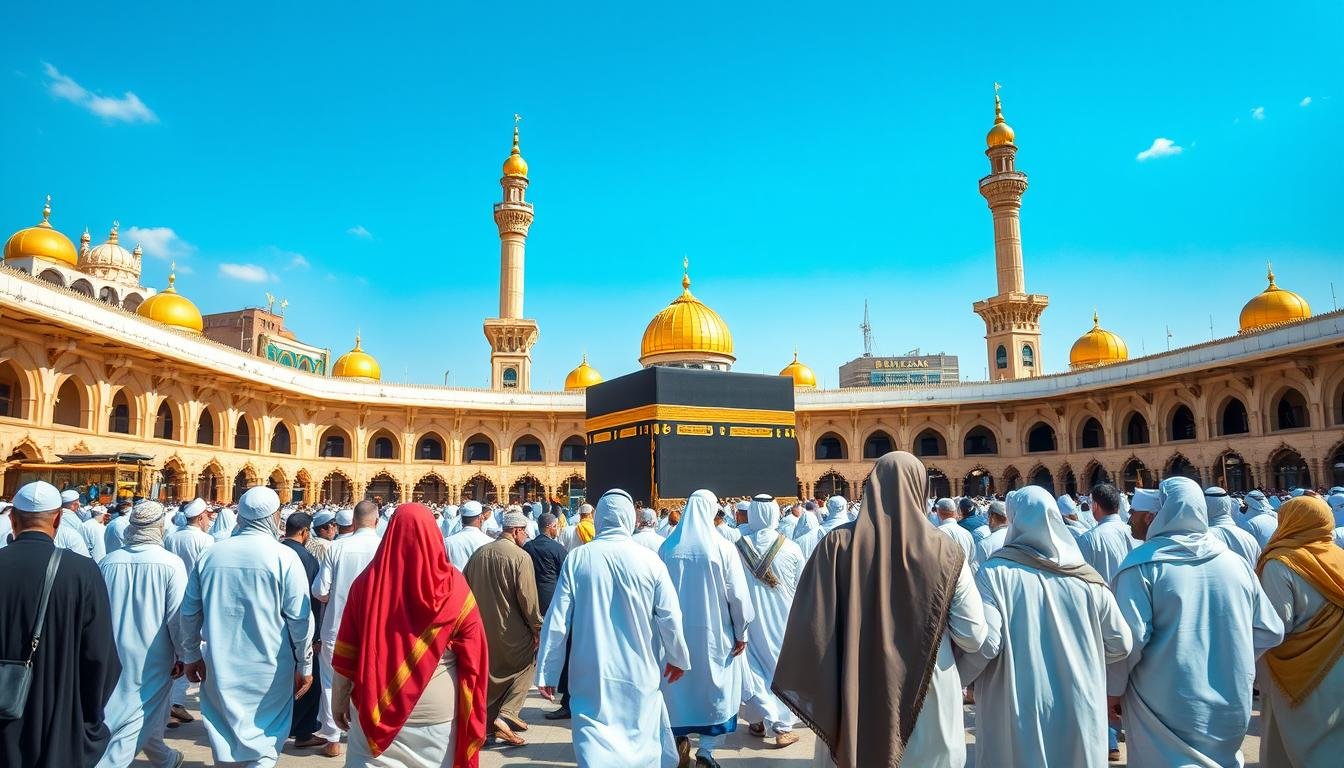Have you ever thought about the most sacred ziyarat (pilgrimage) sites in Saudi Arabia? These places are filled with deep spiritual meaning. They call out to believers from everywhere to start a journey of change. But why are these sites so special, and how can you get the most out of your trip?
In this detailed guide, we’ll explore Saudi Arabia’s most sacred ziyarat sites. We’ll look at their history, cultural importance, and the right way to visit these holy places. Whether it’s your first pilgrimage or you want to strengthen your spiritual bond, this article will guide you.
Understanding Ziyarat: The Spiritual Journey in Islam
Ziyarat is visiting sacred Islamic sites, which is very important in the Muslim faith. These pilgrimages help believers connect more deeply with the divine. They also honor the Prophet Muhammad (peace be upon him). Learning about Ziyarat, Umrah, and Hajj can give us a better understanding of Islamic pilgrimage.
Historical Significance of Islamic Pilgrimages
The tradition of Islamic pilgrimage started with Prophet Muhammad. He taught the value of visiting holy sites to strengthen faith. Over time, these journeys have become a big part of Muslim culture. Millions of believers go to places like the Islamic pilgrimage sites in Saudi Arabia.
Difference Between Hajj, Umrah, and Ziyarat
- Hajj: This is the annual pilgrimage to Makkah. It’s a must-do for all able-bodied Muslims at least once in their life.
- Umrah: This is a voluntary trip to Makkah. It can be done at any time, often with Hajj or alone.
- Ziyarat: It’s visiting sites connected to the Prophet Muhammad, his family, and other important Islamic figures.
Spiritual Benefits of Visiting Sacred Sites
Going on Umrah and Hajj rituals or Ziyarat has many spiritual benefits. These journeys help with self-reflection, repentance, and renewing faith. Visiting these sites can inspire a sense of purpose, humility, and closeness to the divine.
Saudi Arabia’s Most Important Ziyarat Destinations Explained
Saudi Arabia is a key place for Muslims, with millions visiting each year. They go to the holy cities of Makkah and Madinah for a deep spiritual journey. These places are among the most sacred in Islam.
Makkah is where Prophet Muhammad (peace be upon him) was born. It’s home to the Masjid al-Haram and the Kaaba. Pilgrims perform the Hajj and Umrah here, circling the Kaaba and praying in the mosque.
The Zamzam Well is also in Makkah. It’s believed to have been created to help Ishmael and Hagar.
In Madinah, the Prophet’s Mosque, or Masjid an-Nabawi, is a sacred place. People visit to pray and see the Prophet’s tomb. They also explore sites linked to his life and teachings.
The Baqi’ cemetery is another key site in Madinah. It’s where many of the Prophet’s family and friends are buried.
| Ziyarat Destination | Significance |
|---|---|
| Masjid al-Haram, Makkah | Houses the revered Kaaba, the focal point of Islamic worship and the destination for the Hajj and Umrah pilgrimages |
| Zamzam Well, Makkah | Believed to have sprung from the ground to quench the thirst of Ishmael and Hagar |
| Masjid an-Nabawi, Madinah | The mosque where the Prophet Muhammad is buried and a sacred sanctuary for pilgrims |
| Baqi’ Cemetery, Madinah | Resting place of many of the Prophet’s family members and companions |
These places in Saudi Arabia are very important for Muslims. They offer a chance to connect with Islam’s history and teachings. It’s a journey that can deeply transform one’s spirit.
The Holy Mosque of Makkah: Heart of Islamic Pilgrimage
The Masjid Al-Haram, or the Holy Mosque, in Makkah is the spiritual heart of the Islamic world. It is the location of the sacred Kaaba. This mosque is very important for Muslims everywhere, as it is the center of both the Umrah and Hajj pilgrimages.
The Sacred Kaaba and Its Significance
The Masjid Al-Haram has the Kaaba at its center. This cube-shaped structure is covered in a black cloth with gold calligraphy. It is believed to have been built by the Prophet Abraham and his son Ishmael.
It is seen as the symbolic house of God. Muslims face the Kaaba during their daily prayers, no matter where they are in the world.
Notable Areas Within Masjid Al-Haram
The Masjid Al-Haram is a vast and intricate complex. It has several areas that are very important for pilgrims. These include:
- The Multazam: The area between the Kaaba and the Black Stone, where pilgrims often pray and make supplications.
- The Maqam Ibrahim: The station of the Prophet Abraham, where he stood to build the Kaaba.
- The Zamzam Well: A historic well that is believed to have sprung forth to quench the thirst of Hagar and her son Ishmael.
Proper Etiquette and Practices
Visiting the Masjid Al-Haram requires following certain rules. Pilgrims must wear modest clothes and behave properly. They should also recite the Quran, perform prayers, and make supplications.
Understanding and respecting these rules is key for a meaningful visit to this sacred site.
| Ritual | Description |
|---|---|
| Tawaf | Circling the Kaaba seven times in a counter-clockwise direction as an act of worship |
| Sa’i | Brisk walking between the hills of Safa and Marwah, commemorating Hagar’s search for water |
| Ihram | Wearing the prescribed white, seamless garments during Umrah and Hajj rituals |
Prophet’s Mosque in Madinah: A Sacred Sanctuary
Madinah is where the Prophet Muhammad found refuge and started the first Muslim community. It’s home to the Prophet’s Mosque, a sacred site for Muslims. Millions visit each year, drawn by its spiritual importance.
The Prophet’s Mosque, or Masjid al-Nabawi, sits where the Prophet Muhammad’s house was. It’s the second most sacred place in Islam, after the Kaaba in Makkah. Its stunning architecture, with a green dome and detailed designs, showcases Islamic heritage.
The mosque is famous for the Prophet Muhammad’s tomb. Pilgrims from all over come to honor him and seek blessings. The Rawdah, believed to be part of Paradise, and the Minbar, where the Prophet preached, are also key areas.
Visiting the Prophet’s Mosque is a deeply moving experience. The calm atmosphere and the chance to connect with the Prophet’s legacy make it a highlight for Islamic pilgrims in Saudi Arabia.
Historical Sites in Makkah: Beyond the Grand Mosque
The Masjid al-Haram, with the Holy Kaaba, draws millions of pilgrims. But Makkah has more historical and religious sites. These sites offer a deeper look into Islam’s heritage and Makkah’s role as the Islamic faith’s heart.
Cave of Hira and Its Historical Context
The Cave of Hira is a revered site in Makkah. It’s where the Prophet Muhammad (peace be upon him) got his first Quran revelation. This cave, on Jabal al-Nur, is key to understanding the Prophet’s mission.
Mount Arafat and Its Significance
Mount Arafat, 12 miles east of Makkah, is a key pilgrimage site. It’s where the Prophet Muhammad (peace be upon him) gave his final sermon. Millions of pilgrims come here each year for prayers and to seek forgiveness.
The Historic Mina Valley
The Mina Valley, a few miles east of Makkah, is important for Islamic pilgrimages. It’s where pilgrims spend the night of the 10th of Dhul-Hijjah. The valley is significant for its role in Hajj rituals, including the stoning of the devil.
| Site | Significance |
|---|---|
| Cave of Hira | The place where the Prophet Muhammad received his first revelation of the Quran |
| Mount Arafat | The location of the Prophet’s final sermon, a pivotal moment in Islamic history |
| Mina Valley | The site of various Hajj rituals, including the symbolic stoning of the devil |
Visiting these sites beyond the Grand Mosque offers a deeper understanding of Makkah. These places remind us of the Prophet’s life and the moments that shaped Islam. They inspire a deep spiritual connection for the faithful.
Sacred Locations in Madinah: Tracing Prophet’s Steps
In Madinah, there’s more than just the Prophet’s Mosque. Many other sites are sacred for Muslims. These places are linked to Prophet Muhammad’s life and teachings. They let visitors follow his path and feel the faith’s deep history.
The Quba Mosque is a key site. It was the first mosque built. Prophet Muhammad laid its foundation stone and led the first Friday prayer here. Many pilgrims come to pray and seek blessings.
The Masjid al-Qiblatayn, or Mosque of the Two Qiblas, is also important. It marks the change in prayer direction from Jerusalem to the Kaaba in Makkah. This event is a major part of Islamic history.
- Visitors can see the two mihrabs, one facing Jerusalem and the other the Kaaba.
- The mosque is also known for its connection to the Prophet’s companions and their early roles in Islam.
Mount Uhud, just outside Madinah, is another significant site. It’s where the Battle of Uhud, a major Islamic battle, happened. Pilgrims climb the mountain to honor those who died in the battle.
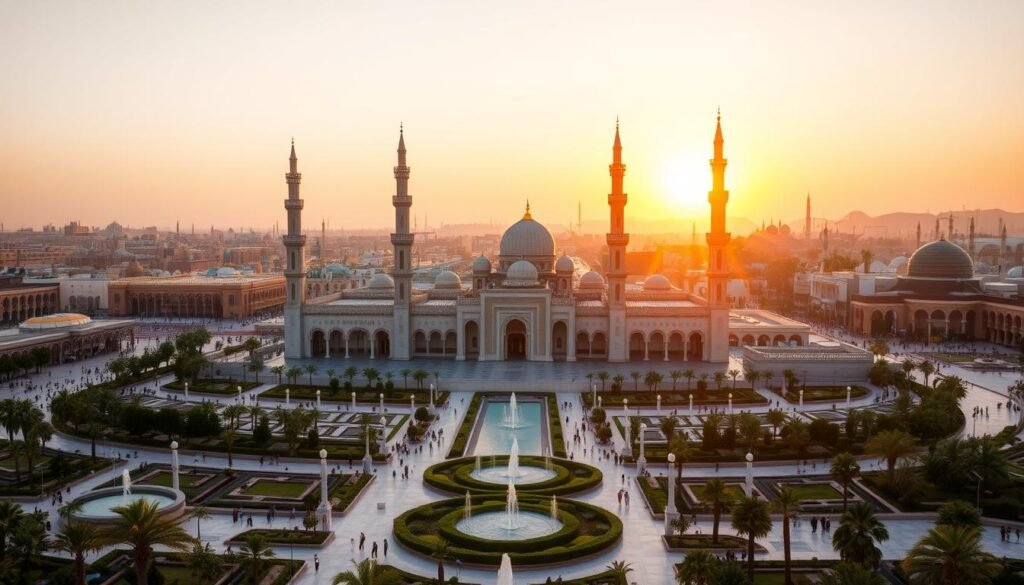
These sites in Madinah give pilgrims a chance to dive into Islamic history. They can connect with the Prophet Muhammad’s legacy. By visiting, people can grow spiritually and strengthen their faith.
Essential Miqat Locations for Pilgrims
Umrah or Hajj is a life-changing journey for Muslims. It’s filled with deep spiritual meaning. Miqat locations are key, where pilgrims start their journey in Ihram, a ritual of purification.
Understanding Miqat Boundaries
Miqat is where pilgrims put on Ihram clothes and say they’re ready for Umrah or Hajj. These spots are like gates to the pilgrimage. They mark the start of a journey away from everyday life.
Preparing for Ihram at Miqat Points
When pilgrims reach Miqat, they get ready for Ihram. They wash, wear simple white clothes, and say the Talbiyah. This shows they’re ready to leave worldly worries behind and focus on their spiritual journey.
| Miqat Location | Nearest City | Significance |
|---|---|---|
| Dhu’l-Hulayfah | Madinah | The Miqat point for pilgrims from Madinah and those passing through it. |
| Juhfah | Rabigh | The Miqat point for pilgrims from the Levant, Egypt, and North Africa. |
| Qarn al-Manazil | Taif | The Miqat point for pilgrims from Najd and the eastern regions of Saudi Arabia. |
| Yalamlam | Makkah | The Miqat point for pilgrims from Yemen and those passing through it. |
| Dhatu Irq | Makkah | The Miqat point for pilgrims from Iraq and the north. |
Knowing Miqat locations and preparing for Ihram are key steps in Umrah and Hajj. By understanding these boundaries and following the rituals, pilgrims can start their spiritual journey with deep reverence and connection to the divine.
Preparing for Your Ziyarat Journey
Planning a ziyarat, or spiritual pilgrimage, to Saudi Arabia’s most important Islamic sites requires careful preparation. Whether you’re embarking on the Umrah or Hajj rituals, understanding the necessary steps can help ensure a meaningful and fulfilling journey.
First and foremost, securing the appropriate visa is crucial. The Saudi government offers specialized ziyarat visas, which you’ll need to obtain well in advance. Be sure to have all necessary travel documents, such as a valid passport, ready before applying.
- Research visa requirements and application process
- Ensure your passport is valid for at least 6 months
- Make copies of important documents, including your visa and passport
Next, consider your health and physical fitness. The holy sites in Saudi Arabia can involve extensive walking and navigating crowded areas. Consult with your healthcare provider to ensure you’re ready for the physical demands of the pilgrimage.
- Obtain necessary vaccinations, such as for meningitis and influenza
- Pack any essential medications and a basic first-aid kit
- Familiarize yourself with local medical facilities and emergency services
Finally, pack wisely to make the most of your ziyarat experience. Bring comfortable, modest clothing that adheres to the dress code, as well as essential items like a prayer mat, Qibla compass, and travel-sized toiletries.
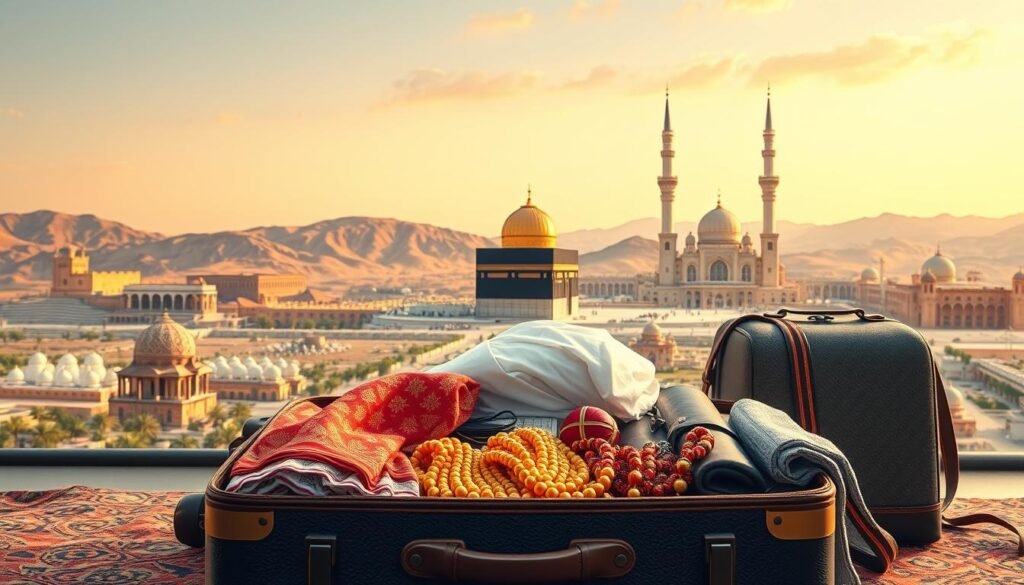
By taking the time to prepare thoroughly, you can embark on your ziyarat journey to Saudi Arabia’s most important destinations with confidence and a deep sense of spiritual fulfillment.
Modern Facilities and Accommodations Near Sacred Sites
Visiting the sacred Islamic pilgrimage sites in Saudi Arabia, like the Holy Mosque of Makkah and the Prophet’s Mosque in Madinah, needs careful planning. The kingdom has built modern infrastructure and accommodations for pilgrims. This ensures a comfortable and easy experience.
Transportation Options
There are many ways to get to and from the holy sites. You can take taxis, use ride-sharing services, or book private transfers. The country also has buses and trains that connect major pilgrimage sites. This makes traveling between them easy.
Medical Facilities and Emergency Services
Saudi Arabia focuses on the health of pilgrims. Many hospitals and clinics are near the sacred sites. They have skilled medical staff ready to help with any health issues. Emergency teams are also ready to assist quickly in medical emergencies.
| Accommodation Type | Proximity to Sacred Sites | Average Cost per Night |
|---|---|---|
| Budget Hotels | Within 5 km | $50 – $100 |
| Luxury Hotels | Adjacent to or within 1 km | $200 – $500 |
| Serviced Apartments | Within 3 km | $80 – $150 |
Pilgrims have many accommodation choices, from budget hotels to luxury resorts. They can pick what fits their needs and budget while staying near the Islamic pilgrimage sites in Saudi Arabia.
Best Times to Visit Sacred Sites
Planning a spiritual journey to Saudi Arabia’s sacred sites is key. Knowing the best times to visit can make your experience richer. Whether for Umrah or Hajj, picking the right season is crucial.
The holy months of Ramadan and Dhul-Hijjah are the peak times. These months attract many pilgrims, creating a deep sense of community. Yet, they also mean big crowds, higher costs, and harder to find places to stay.
For a calmer experience, try the off-peak seasons. Shoulder seasons like Sha’ban and Shawwal are quieter. They let you focus on the spiritual side of these places without the rush.
| Season | Pros | Cons |
|---|---|---|
| Peak Season (Ramadan, Dhul-Hijjah) | Vibrant atmosphere Sense of community Increased religious activities | Larger crowds Higher prices Accommodation challenges |
| Off-Peak Season (Sha’ban, Shawwal) | Quieter and more serene atmosphere Lower prices Easier to secure accommodations | Fewer religious activities Potentially hotter weather |
Weather, crowd levels, and religious events are key when planning your visit. Timing your trip right can make your spiritual journey unforgettable.
Cultural Etiquette and Religious Guidelines
Visiting the sacred Islamic pilgrimage sites in Saudi Arabia requires respect for cultural and religious rules. It’s important to follow these guidelines to show respect and reverence. This includes the dress code and how to behave during your visit.
Dress Code Requirements
The dress code in Saudi Arabia is about modesty and respect. Men should wear loose, long pants and shirts that cover their shoulders. Women need to wear long dresses or abayas that hide their shape. They also need to cover their heads with a scarf or hijab.
Behavioral Protocols
When you visit these sacred sites, be calm and respectful. Don’t talk loudly, take pictures without permission, or act disrespectfully. Turn off your phone and don’t eat or drink in prayer areas. Always follow the rules and advice from local authorities for a meaningful visit.
FAQ
What are the most important Ziyarat destinations in Saudi Arabia?
The top Ziyarat spots in Saudi Arabia are Makkah and Madinah. Makkah has the Masjid Al-Haram, where the Kaaba is. Madinah is home to the Prophet Muhammad’s Mosque.
What is the difference between Hajj, Umrah, and Ziyarat?
Hajj is a yearly Islamic trip to Makkah for all Muslims. Umrah is a voluntary visit to Makkah any time. Ziyarat is visiting holy places like the Masjid Al-Haram and the Prophet’s Mosque.
What are the notable areas within the Masjid Al-Haram in Makkah?
The Masjid Al-Haram has key spots like the Kaaba and the Zamzam Well. Pilgrims do rituals and prayers here during Umrah and Hajj.
What are the historical sites in Makkah beyond the Grand Mosque?
Makkah has sites like the Cave of Hira and Mount Arafat. These are important for Hajj. The Mina Valley is also crucial for the pilgrimage.
What are the key sacred locations in Madinah outside the Prophet’s Mosque?
Madinah has sites like the Quba Mosque and Mount Uhud. The Masjid al-Qiblatayn is also significant. These places are important in Islam.
What are the Miqat locations, and why are they important for pilgrims?
Miqat points are where pilgrims start their Ihram. This means wearing special clothes and following rules. It’s key for Hajj and Umrah.
What are some essential preparations for a Ziyarat journey to Saudi Arabia?
Preparing for a Ziyarat trip includes getting a visa and travel documents. You should also think about health and pack the right clothes.
What modern facilities and accommodations are available near the sacred sites in Saudi Arabia?
Saudi Arabia has great facilities for pilgrims. There are many places to stay, good transport, and medical services near the holy sites.
What are the best times to visit the sacred sites in Saudi Arabia?
The best times to visit depend on weather, crowds, and religious events. Spring and fall are usually best, with good weather and fewer people.
What cultural and religious etiquette should visitors observe at the sacred sites in Saudi Arabia?
Visitors should follow local customs and mosque rules. This includes dressing properly and being respectful. It’s important to follow the guidelines for the holy places.
Don’t forget to share your experience in the comments and follow us on social media at the bottom of the site.
